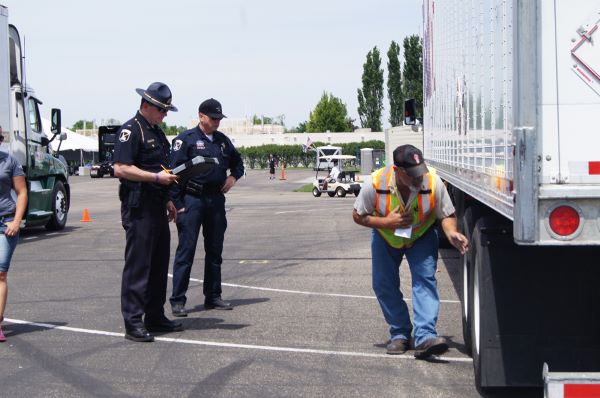The upcoming North American Roadcheck, organized by the Commercial Vehicle Safety Alliance (CVSA), is set to begin next month from May 14-16. During this inspection spree, inspectors will be vigilant for a range of equipment and driver infractions, such as brake and tire wear issues, adherence to hours of service regulations, and specifically, they’ll be placing special emphasis on tractor protection controls within the air system and detecting alcohol and controlled substance possession.
Jeremy Disbrow, a Roadside Inspection Specialist with 21 years of law enforcement experience, shared insights into what inspectors will be focusing on and offered tips for truckers to excel during this annual event. Disbrow will be participating as a special guest in a live Q&A session hosted by CCJ and Bestpass in two weeks, where he’ll address audience questions. Registration and submission of questions for the session are available here.
Each year, the CVSA, in collaboration with industry stakeholders and law enforcement, selects two primary areas of focus. This year, according to Disbrow, the consensus, particularly from the industry’s perspective, revolved around the FMCSA’s Drug and Alcohol Clearinghouse database and the tractor protection valve – both of which are considered significant issues.
Disbrow highlighted the prevalence of drivers being barred from operating due to entries in the clearinghouse, with marijuana use being a notable factor. He attributed this trend to the growing number of states legalizing marijuana, emphasizing the importance of drivers understanding that even if marijuana is legal in their state, positive test results can still occur during mandatory screenings conducted by employers and truck owner-operators.
Any association with cannabis, including the use of related products like CBD, should alert drivers, as there are numerous documented instances of drivers failing drug tests for marijuana despite not directly using the substance. Sandra Irwin’s experience with CBD, a derivative of cannabis or hemp often used for pain management, exemplifies the complexities and challenges of the “Return to Duty” process, where adherence to all required steps may not immediately result in employment opportunities.
Disbrow expressed concern that drivers may not fully grasp the potential consequences of using such products, regardless of how readily available they are in places like gas stations or vape shops, and emphasized that they pose a significant threat to a commercial driver’s career.
This year’s Roadcheck aims not only to educate professional truckers about this risk but also to raise awareness among inspectors. Disbrow noted that while inspectors may not have always been thorough in identifying these issues, there is a growing emphasis on checking the Clearinghouse database more rigorously. The goal for this year is to ensure that inspectors verify a driver’s CDL status in the Clearinghouse during every inspection.
Disbrow reminded truckers that having drugs or alcohol in the vehicle is strictly prohibited for drivers, emphasizing this as another critical aspect to be mindful of. Any drivers found in possession of drugs or alcohol, or listed in the Clearinghouse as prohibited, will be sidelined from service.
Regarding the looming federal deadline in November of this year for states to downgrade CDLs of drivers with prohibited status in the Clearinghouse, Disbrow reported that most states have already taken action, having downgraded the licenses of drivers who tested positive.
Tractor protection valve
Disbrow explained the critical function of the tractor protection valve, which maintains a reserve of air in the system in case the tractor and trailer become separated or if the gladhands disconnect. This reserve of air, typically at least 20 psi, is essential for ensuring safe braking in the event of an air hose separation between the truck and trailer.
In practical terms, this reserve can prevent a minor incident from escalating into a major accident by enabling the tractor to come to a halt before potentially causing a collision or obstructing traffic, especially during peak hours.
Inspecting this valve is already a standard part of the comprehensive Level I inspection, consisting of 37 steps, and has been for some time. During this inspection, inspectors typically secure the wheels to prevent movement, release all brakes, and detach both gladhands to listen for escaping air. Once the air stops escaping and the pressure remains at or above 20 psi, the valve is deemed operational.
Disbrow advised drivers to incorporate checking this valve into their pre-trip routine if it isn’t already part of it. However, he warned against shortcuts or inadequate methods of testing. Simply pumping down the brakes and waiting for the dash valve to activate is insufficient and doesn’t accurately assess the functionality of the tractor protection valve.





